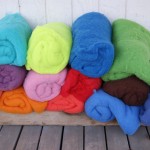 Before shedding light on wool felt, let us learn about felt or felting. The term felt is the name given to a textile that is produced after a process of matting, condensing and pressing of different fibers altogether. There are different types of felt products produced in the industry. Some are made from natural fibers like wool and some from synthetic ones like acrylic. Felts may be divided into various types according to their functions like industrial felts, crafting applications, designer felts and some technical ones as well. Some felts are very soft and used for purposes that require delicacy while others are hard enough to sustain construction processes. Every felt material is described on the basis of a few features that include:
Before shedding light on wool felt, let us learn about felt or felting. The term felt is the name given to a textile that is produced after a process of matting, condensing and pressing of different fibers altogether. There are different types of felt products produced in the industry. Some are made from natural fibers like wool and some from synthetic ones like acrylic. Felts may be divided into various types according to their functions like industrial felts, crafting applications, designer felts and some technical ones as well. Some felts are very soft and used for purposes that require delicacy while others are hard enough to sustain construction processes. Every felt material is described on the basis of a few features that include:
- Content of fiber in the felt
- Color of the felt
- Size and thickness of the felt
- Density and many other physical factors related to the purpose for which the felt is manufactured.
One very frequently used and common available form of felt is wool felt.
What is Wool Felt?
Wool felt is a type of felt textile that is fire-retardant and extinguishes on itself. This type of felt material is produced using the process of wet felting. Wet felting involves the use of water or moisture, a lubrication agent like soap and the friction process that can be done manually by using your hands. This process leads to the entangling of various fibers and as a consequence a wool Felt is produced.
Hence we see that wool felt is primarily a non-woven textile material that can be used for various purposes. The impure form of wool felt contains at least 30% wool components, as without it there cannot be the creation of a stable fabric. So if you are looking for fire-resistant textiles then you should consider buying wool felts.